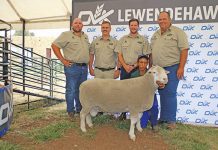The Dublin Horse Show is Ireland’s oldest equestrian festival and dates back to 1864. Today, the well-sponsored annual show, held at the Royal Dublin Society Showgrounds (RDS), symbolises international respect for the Irish equestrian community. Mike Burgess, visited the show in August where, among others, the renowned Irish Sports Horse competes in numerous show classes and prestigious show jumping events.
The largest equestrian event on the Irish calendar, the Fáilte Ireland Dublin Horse Show, attracted close to 1 500 horses, involved in showing and various competitions, to the heart of Ireland’s capital this year. According to Martin Cullen, minister for arts, sports and tourism, the show is aimed at showcasing the equestrian community of Ireland, and its contribution to the broader equestrian world. ”This major international occasion brings together world-class eventing and jumping contests where Irish-bred, -owned and -trained horses demonstrate why Ireland is truly the ”land of the horse,” Cullen said in his opening address.
At the heart of the Fáilte Dublin Horse Show – visited by as many as 27 000 international visitors – is the marketing of Irish horses within the structures of the increasingly centralised Sport Horse (ISH) industry. The industry contributes about €400 million (R5 billion) to the economy each year, viasome 110 000 Irish Sport Horses, 27 000 classed breeding mares and 53 000 human participants, at any given time.
A breed apart
However, it must be said that the ISH and the world-famous indigenous Irish Connemara pony have been marketed exceptionally well and are today globally renowned for ability, breeding, courage, intelligence, strength and temperament. The ISH, bred in different weight classes, is mainly a cross between the Irish draught horse and Thoroughbred horses.
According to many, it’s the ideal and preferred horse for all equestrian disciplines from leisure riding to international eventing. This is perhaps best illustrated by the way the ISH has topped the World Breeding Federation for sport-horse event rankings for the past 13 years. It’s accepted in Ireland as nothing short of a national treasure and treated as such. Since 2008 the ISH sector has been represented by Horse Sport Ireland (HSI), a new government agency created to fuse sporting, breeding and leisure for better promotion.
The HSI is recognised by both the International Equestrian Federation (FEI) and the Olympic Council of Ireland (OCI), a major sponsor of the Dublin Horse Show. The HSI aims to develop a market for Irish-bred horses, while setting standards and rewarding improvements in performance and breeding. The knowledge many ordinary Irish folk have about Irish horses and breeding standards can be closely linked to the quality of Irish-bred horses. At the popular Public Judging Competition, members of the public select winners from showing classes for cash prizes up of to €1 000 (R12 515).
However, many agree the highlights of the show revolve around eventing and show jumping in the large revamped main arena of the Royal Dublin Society Showgrounds. These categories have a long and proud history, and “horse leaping” events became prominent as early as 1869. Today, with 35 national Irish jumping competitions and almost 15 international jumping events, the show is a leading international show-jumping event. Undoubtedly, the highlight is the historic Nations Cup competition for the Aga Khan Trophy, first presented in 1926.
A historic idea
The idea of the Nations Cup was sparked in 1925 when Colonel Zeigler of the Swiss Army suggested an event between military officers from different countries. pSo impressed was the Aga Khan of the time – the spiritual leader of the international community of the Shia Imami Ismaili Muslims – that he donated a trophy in honour of his enjoyment of previous Irish horse shows in Dublin, and of his Irish tutor, a certain Mr Kenny. The gesture led to one of the most famous show jumping events in Europe with a first place prize of €52 000 (R650 820). By 2003 the Nations Cup for the Aga Khan trophy doubled as one of eight legs of the most prestigious show jumping event in Europe, the Samsung Super League with the FEI. In it four best rider and horse combinations from the eight best international show jumping countries compete at destinations across Europe.
Tough competition; tough rules Long before the Super League, though, the Aga Khan trophy was passionately contested for in Dublin according to some very special rules. Conditions attached to the first trophy in 1926 included that any country able to win for three years non-consecutively would win it outright. In 1930 Switzerland captured it on three Irish horses. More stringent conditions were attached, including a new system of judging and a rule that any team wishing to win outright would have to win in the competition three times in succession.
In 1937 the Irish team achieved this feat, forcing the introduction of new rules in 1938. The 1938 Nations Cup was won by France ending a golden era for Irish show jumping, just four weeks before the Second World War and a 10 year interruption. Then in 1948 the US recorded their first victory to become the first non-European winners. By the 1950s Nations Cup teams could consist of members outside the army, women could compete in international events for the first time, and time limits were introduced. Britian won the Aga Khan trophy outright in 1953. Despite continued competition – except for a minor interruption in the 1960s, due to a swamp fever outbreak, further trophies were only won outright by Britain in 1975, and Ireland in 1979.
France nearly won the present trophy, the sixth variation in the series, in 2004, but a resurgent Irish team denied them the honour. Britian won in 2005 followed by wins by Germany in 2006 and 2007. This year the Germans had the opportunity to be the first team since 1979 to go home with an Aga Khan trophy, but after a tense afternoon they only finished third on 24 faults. Britain took first place on 14 faults, after Nick Skelton extinguished the contest with Ireland after a clear round and a one-time fault in the final round, to leave Ireland in second place on 19 faults, despite the return of Irish show-jumping legend Eddie Macken, who was a member of the immortalised 1979 Aga Khan Trophy winning team. Sources include www.horsesportireland.ie and wwwdublinhorseshow.ie, as well as the official Fáilte Ireland Dublin Horse Show Programme. |fw








